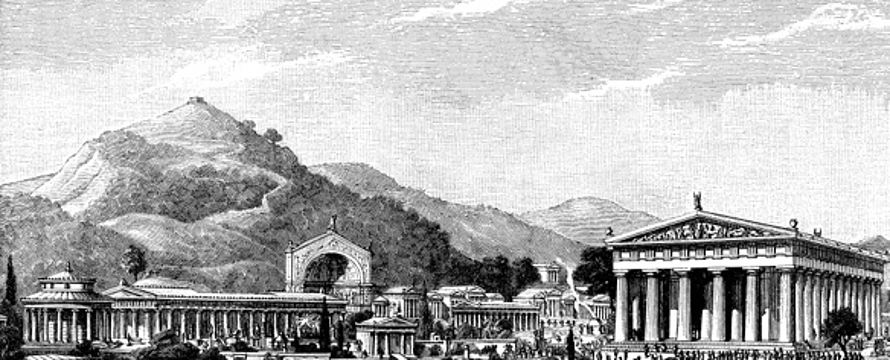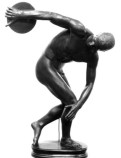
Welcome to the Pioneers of Physical Culture
Statues of Apollo, Hercules, Mars, Nike, Venus and other Gods of the ancient world have for centuries depicted physical perfection. Today they still have a profound effect in shaping the tastes of Artists, Sculptors, Scholars, Culturists and others in Modern Society. Apollo, the Greek God, often represented as the perfect man has been the subject of many statues however; it is believed that these Greek statues were based on Egyptian figures from 1000 years earlier...
It took the Greeks around 100 years to develop the statues which most suitably depict the present day concepts of beauty however, it was around 480 BC that the marble figure known as the ‘Ephebe of Kritios’ emerged, displaying a good approach to a perfect figure in modern terms. Hellenistic and Roman art also produced Statues, Mosaics, Vases and Plates showing athletes of aspriational form. The Olympic statues were true representations of the athletes and the respected philosopher Aristotle said:
“Art completes what nature cannot bring to a finish”. The artist gives us knowledge of nature’s unrealised ends
Of all the Ancient Greek sculptors, Phidias and Polyclitus were long unsurpassed in representing the beauty of the human form. Phidias was best able to depict the majestic proportions of the Olympic Gods and around 448 BC went on to produce one of the seven wonders of the ancient world, the giant gold and ivory statue of Zeus at Olympia. Much of the great work of Phidias and his disciples was destroyed in wars however; some others such as Lysippus depicted athletes in motion and showed subjects at their physical best. Typical of these type of statues was Apoxyomenos where an athlete is seen drying himself after exercise or competition. Phidias was also the favourite sculptor of Alexander the Great
After Alexander the Great died, the Macedonian Armies spread Hellenic culture abroad where it lasted for 300 years until the time of Christ when eventually Roman art took over. Important examples of Hellenistic art include the Laocoon, The Venus De Milo, The Boxer in the National Rome Museum and The Wrestlers by Florence Uffizi
The Emperor Nero 54-68 AD was mainly responsible for introducing Gymnastic exercises into Rome on a significant scale, with their use officially encouraged. Until the last century, the word ‘gymnastics’ was used to signify the practice of exercises for bodily form rather than competitive sport. The practices of physical exercises first became fashionable in Rome as a prelude to the act of ‘Bathing‘ with the Roman love of bathing spreading throughout the empire, and in Britain today examples still exist of beautiful bathing establishments built by the Romans. The Greeks were more orientated towards grace and physical beauty, whilst the Romans worked mainly for strength in warfare
As the Human body in Art became more widely accepted, Hercules and Sampson were popular subjects on canvas or in stone. Antonio Pollajuolo created three paintings of the labours of Hercules for the Medici Palais around 1460 and dissected many bodies to examine their Anatomy. He also was one of the first few to depict a ‘true’ representation of Athletic Musculature, and is recognised as a true Pioneer of authentic physique studies
The outstanding genius in art and sculpture of Leonardo DaVinci and Michelangelo is widely known in their physique representations such as Hercules etc becoming more enduring than any other present day studies. Leonardo’s contention that an artist should not only know the appearance of the muscles but also their detailed anatomy putting great emphasis on the muscles themselves, illustrating how they bunched up when contracted and lengthened when relaxed and concluded in his Treatises 299 and 33;
“Force is produced by the swelling and shortening of the muscles”
“The muscle that is most used is most evident, the one less used is less prompt to act; and the one that does nothing stays slow and soft and inconspicuous”
“Furthermore, the muscles will be more or less bulky according to their development, which in turn depends on the work required of them and on the functional state of a given muscle during its various movements”
As the centuries progressed, Saxon and Norman Kings enjoyed events requiring strength and their professional performers were arguably the physical culturists of their times. Early British Archers practised exercises to increase the distance they could shoot and improve the penetration power of their arrows. Important work was practised with various ‘weighted’ bows and some of the exercises were not unlike modern cable movements and records of practicing archery exercises specifically for bodybuilding, health and general fitness
There was a considerable amount of weight training in France and Germany in the 16th Century and in 1544, Camerarius, a lecturer at Leipzig University, published works recommending weight-training exercises as one of the activities that should be included in a model school. In his ‘Dialogus de Gynasa’, there is a description of a school where weightlifting was practiced daily. In France, Rabelais 1490-1553, mentions the ‘putting up’ of lead dumbbells
Many writers over the centuries have encouraged and promoted bodily exercises. Born in 1500, Physician Dr Christobal Mendel wrote the earliest printed book of exercise and training advice and was published in Seville in 1553. It is believed that there are still two copies of the book in existence and a facsimile was printed from Yale University which contains reference to seven authors writing on exercise; Aristotle, Averroes, Celsus, Galen, Pliny, Plutarch and Ptolemy
Martin Luther and the celebrated physician Mercurialis from 1530-1606, were advocates of weight work producing ‘De Arte Gymnastica’, published in Venice in 1569. One of the earliest medical books to contain to include the importance of Body Culture and Athleticism was Francis Fuller’s ‘Medicina Gymnastica’ or ‘A Treatise concerning The Power of Exercise’, first published privately in London in 1705. Towards the end of the 18th century, a German named Basedow founded a school of physical education where one of the exercises taught was carrying bags of sand in a crucifix position. Although there are only a few references, it is important to note that all exercises and the recommended use of weights are not referred to in negative or derogatory terms
From the 18th century onwards, the physical education teacher, the weight-training instructor and the bodybuilder had a great deal in common. They all had physical improvement as a major aim; they only differed in the matter in degree of development.
“The striving for physical beauty and the striving for physical health proceed along converging lines which finally meet at one point - the perfect body”
In 1864, K. A. Knudsen was the Chief Inspector of Physical Education in Denmark and author of many books on Educational Gymnastics. He said that the ideal teacher of physical exercise should have an artist’s eye for bodily beauty in positions and movements - "He is like a sculptor of the living body", a wonderful concept
The Pioneers of Physical eCulture continued to encourage a solid foundation for development, Johann Guts-Muth 1759 -1839 produced an encyclopaedia of bodily exercises saying
“You shall be a sane supervisor and master of your body, making it skilful and obedient to all that is good”
Friedrich Jahn 1778-1852, devised new exercises and apparatus that presented a plan to promote National Health, well being and physical strength through Gymnastic Societies. He concentrated on post-school work for teenagers and adults. Jahn’s inventions included the Horizontal bars and Parallel bars, the forerunners of our chinning and dipping bars. Several German immigrants to the USA formed gymnastic clubs called ‘Turnen’, which played an important role in early American Physical Culture. Franz Nachtegall 1777-1847, opened a Gymnasium in Copenhagen frequented by Danish Royalty. His successor in Sweden was Pehr Henrik Ling 1776-1839, who developed the famous system of Swedish Gymnastics. Wall bars, beams and the box horse were just a few of his inventions but importantly, he progressed from educational to remedial work, which has had a lasting effect
In Britain, P. H. Clias 1782-1854 trained and developed work with the Armed Forces. In 1823, he published ‘An Elementary Course of Gymnastic Exercises Intended to Develop the Physical Powers of Man’. In 1834, Donald Walker, a protégé of P.H. Clias, followed with his book ‘British Manly Exercises’
The finest Private Gymnasium in mid-19th Century Britain was owned by Archibald McClaren. His clientele was the fashionable University fraternity, titled, many of whom were influential and recommended his system as the best of its kind, to be widely used by teachers and coaches. In 1863, he published ‘National Systems of Bodily Exercise‘. Strength and stamina was his main objective and a strong advocate of ‘all round’ training. His greatest contribution came in the form of a physical scheme of work for the British Army and training instructors in his methods, which included free exercise and apparatus work with barbells and dumbbells
The Pioneers of Physical Culture include the study of Anatomy, Physiology, Elementary Body Mechanics and the principles of movement with the introduction of weight resistance exercise for complete physical development
Shortened version adapted for the Web taken from ‘The History of Bodybuilding’ by David Webster OBE, Social and Humanities Research Associate, The Physical Culture Museum, The Stark Center, University of Texas, USA
This book and many others by David Webster regarding all aspects of Physical Culture and Bodybuilding are available on request

